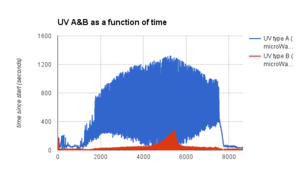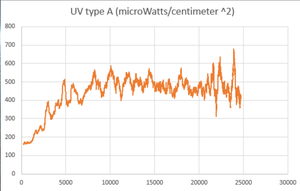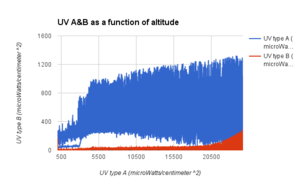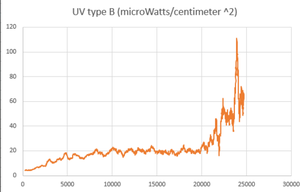Project UV
Project UV is the 2015-2016 Balloons team project to develop effective countermeasures against the UV degradation of latex balloons, in order to increase the potential flight time of future payloads.
The current team leads are Davy Ragland and Yuji Sugimoto.
Chemical protection
Because ultra violet radiation physically degrades the polymers within the latex, a chemical solution may elongate its lifespan. A preliminary test was done with a set of various chemical coatings, balloon types, and strech values. However, the test had to be stopped for winter break, so the degradation point of some samples could only be predicted, not verified. Nevertheless, the initial results seem optimistic. While the sunscreen made the latex brittle, the Anti-UV Scuba spray seemed to elongate the lifespan.
SSI-28
In order understand the exact effect of ultra violet A and B present at different altitudes, a sensor for each UV type was launched on the SSI-28 launch. From the collected data, it can be concluded that there is much more UV A than UV B, and it does in fact increase with altitude, reaching a max value of 1323 microwatts/cm^2 for UV A and 292 microwatts/cm^2 for UV B. In addition, there was a lot of oscillation in values, which is due to the sensor being on one side, and the payload spinning during its flight. Thus, the value where the sun is directly facing the latex would correspond to the high part of the wave.
Chemical concentration
As result of the positive results of the chemical protection tests, and the new UV intensity data from SSI-28, a new experiment will be done indoors with UV LEDs that emit light at 365 manometers at a constant intencity. This will be to control for and calculate the exact amount of UV that the latex is being exposed to, in order to determine the proportion of UV concentration to natural sunlight at the desired altitude. The independent variable will be the concentration of chemical spray per area, which will be tested against the independent variable of lifespan, in order determine the ideal amount of Anti-UV Scuba spray to apply onto the balloon.
Application
Once the ideal concentration of protective chemicals per surface area is determined, an effective method of application will be developed, in order to ensure that the right amount of chemicals are placed on the right area. Current ideas include converting it into an aerosol or soaking the balloon.
Gallery
| Balloon Launches | |
|---|---|
| 2014-15 | SSI-19 • 20 • 21 • 22 |
| 2015-16 | SSI-23(a) • 24 • 25 • 26 • 27 • 28 • 29 • 30 • 31 • 32 • 33 • 34 • 35 • 36 • 37 • 38 • 39 • 40 • 41 • 42 • 43 |
| 2016-17 | 44 • 45 • 46 • 47 • 48 • 49 • 50 • 51 • 52 |
| 2017-18 | |
| 2018-19 | 83 • 86 • 87 • 90 • 91 |
| 2019-20 | 92 • 93 • 97 |
| V • E | |




